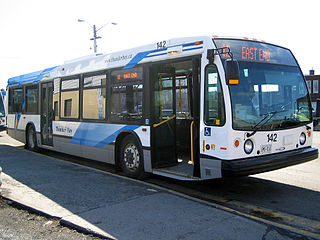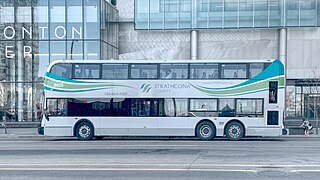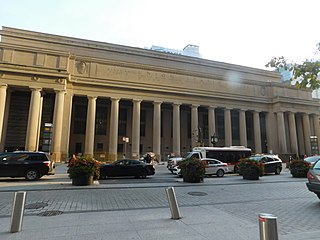
Grand River Transit (GRT) is the public transport operator for the Regional Municipality of Waterloo, Ontario, Canada. It operates daily bus services in the region, primarily in the cities of Kitchener, Waterloo, and Cambridge, alongside the ION rapid transit light rail system which began service on June 21, 2019.

The Niagara Frontier Transportation Authority (NFTA) is the public agency responsible for operating most public transportation services in the Buffalo–Niagara Falls metropolitan area. The NFTA, as an authority, oversees a number of subsidiaries, including the NFTA Metro bus and rail system, the Buffalo-Niagara International Airport, the Niagara Falls International Airport and NFTA Small Boat Harbor. The NFTA Metro bus and rail system is a multi-modal agency, utilizing various vehicle modes, using the brand names: NFTA Metro Bus, NFTA Metro Rail, NFTA Metrolink and NFTA PAL. In 2022, the system had a ridership of 14,061,700 or about 54,000 per weekday as of the third quarter of 2023. In addition, the NFTA also owns and manages a number of properties, including the Buffalo Metropolitan Transportation Center in Downtown Buffalo ; the Niagara Falls Transportation Center on Factory Outlet Boulevard; the Portage Road Transit Center in Niagara Falls; and a number of strategically located bus loops and transit centers in the Buffalo Niagara region. Of note, many of the bus loops have been in continuous operation since the days of the International Railway Company, a predecessor to the NFTA. Agency-wide, the NFTA employs 1,500 full-time and part-time employees. There are three business centers that operate as the NFTA organization: Surface Transportation, which handles ground transportation throughout Erie and Niagara counties, Aviation, which handles air related business at the Buffalo-Niagara International Airport and Niagara Falls International Airport and Property Risk/Management, which operates the NFTA-Boat Harbor and handles other properties that are owned and/or operated by the NFTA.

Calgary Transit is the public transit agency which is owned and operated by the city of Calgary, Alberta, Canada. In 2019, an estimated 106.5 million passengers boarded approximately 1,155 Calgary Transit vehicles. It operates light metro (LRT), urban tramway, bus rapid transit (BRT), para-transit, and regular bus services. In 2022, the system had a ridership of 103,306,500, or about 421,000 per weekday as of the third quarter of 2023.

Hillsborough Area Regional Transit provides public transportation for Hillsborough County, Florida. The agency provides fixed-route local and express bus service, door-to-door paratransit service (HARTplus), flex-route neighborhood connector service (HARTflex), a lightened version of bus rapid transit (MetroRapid), and manages the TECO Line Streetcar system.

The Hamilton Street Railway (HSR) is the public transport agency for Hamilton, Ontario. The name is a legacy of the company's early period, when public transit in Hamilton was primarily served by streetcars. Although streetcars are no longer used in the city today, the HSR operates bus and paratransit services, with a ridership of 21 million passengers a year.

The Edmonton Transit Service (ETS) is the public transit service owned and operated by the City of Edmonton in Alberta, Canada. It operates Edmonton's bus and light rail systems. In 2022, the system had a ridership of 68,829,300, or about 264,700 per weekday as of the third quarter of 2023.

The San Diego Electric Railway (SDERy) was a mass transit system in Southern California, United States, using 600 volt DC streetcars and buses.

The Toronto streetcar system is a network of eleven streetcar routes in Toronto, Ontario, Canada, operated by the Toronto Transit Commission (TTC). It is the third busiest light-rail system in North America. The network is concentrated primarily in Downtown Toronto and in proximity to the city's waterfront. Much of the streetcar route network dates from the 19th century. Three streetcar routes operate in their own right-of-way, one in a partial right-of-way, and six operate on street trackage shared with vehicular traffic with streetcars stopping on demand at frequent stops like buses. Since 2019, the network has used low-floor streetcars, making it fully accessible.

The Guelph Transit Commission is a small public transportation agency that operates transit bus services in Guelph, Ontario, Canada. Established in 1929 after the closure of the Guelph Radial Railway Company streetcar lines, Guelph Transit has grown to comprise over 70 buses serving 28 transit routes.

The London Transit Commission (LTC) is responsible for the operation of the public transit system on behalf of the City of London, Ontario, Canada. It operates transit bus service and para-transit service. In 2014, annual ridership totaled 24.1 million. The LTC has 28 regular bus routes, six express routes, three school-year-only routes and six community bus routes.

Regina Transit is the public transportation agency operated by the City of Regina, Saskatchewan, Canada. It is the oldest public transit system in Saskatchewan and has been city-owned since its inception.

Winnipeg Transit is the public transit agency, and the bus-service provider, of the City of Winnipeg, Manitoba. Established 141 years ago, it is owned by the city government and currently employs nearly 1,600 people—including approximately 1,100 bus drivers.

Tucson Transit Management LLC, doing business as Sun Tran, is the public transit system serving the city of Tucson, Arizona. In 2022, the system had 15,717,100 rides, or about 57,500 per weekday as of the third quarter of 2023. 100% of the fleet utilizes clean-burning fuels, such as compressed natural gas (CNG), biodiesel, and hybrid technologies. In addition to more than 40 bus routes, the system also includes the Sun Link modern streetcar line.

Thunder Bay Transit is the public transit operator in Thunder Bay, Ontario, Canada. It was formed in 1970, after the amalgamation of the cities of Port Arthur and Fort William and their respective transit agencies. Thunder Bay Transit is a member of the Canadian Urban Transit Association.

The Central Business District is one of seven development districts in Saskatoon, Saskatchewan, Canada. The central business district is Ward 6 of a Mayor-Council government represented by councillor Cynthia Block. Formerly called West Saskatoon, this area arose when the steam engines built their pumping stations on the lower west bank of the South Saskatchewan River. Retail enterprises sprang up around the newly created train station and rail yards. The city of Saskatoon's Central Business District has shopping malls and boutiques.
The Minneapolis Streetcar System was a proposed streetcar system for the city of Minneapolis, Minnesota. Extensive studies and plans for the new system were completed in 2007 and presented to the Minneapolis City Council in January 2008; on April 2, 2010, the Council voted to approve the plans and seek funding. On December 21, 2010 the Federal Transit Administration granted $900,000 to further study the Nicollet and Central Avenue corridors. In June 2021, after no further development on the system, a bill authorized the Metropolitan Council to use funds collected for the Nicollet-Central line to be spent on bus rapid transit funding.

Strathcona County Transit provides local, commuter, and school bus services to the community of Sherwood Park, Alberta, Canada, which is east of Edmonton in Strathcona County. Transportation for elderly citizens and people with disabilities is provided by Mobility Bus within Sherwood Park and rural Strathcona County. Strathcona County is home to Alberta's first fleet of double-decker buses. It purchased 24 double-decker buses from 2010 to 2020 using a combination of municipal, provincial, and federal funding. In 2022, the system had a ridership of 847,300.

Metro is a transit network in Minnesota serving the cities of Minneapolis and Saint Paul. It also provides service to some suburban areas. As of 2022, the system consists of two light rail lines and five bus rapid transit (BRT) lines all of which are operated by the local public transit company: Metro Transit. The five lines connect Downtown Minneapolis and St Paul with the Bloomington, Minneapolis-St Paul International Airport, Roseville, Richfield, Burnsville and Brooklyn Center.

Public transportation in the Canadian city of Toronto dates back to 1849 with the creation of a horse-drawn stagecoach company. Today, Toronto's mass transit is primarily made up of a system of subways, buses, and streetcars, covering approximately 1,200 km (750 mi) of routes operated by the Toronto Transit Commission (TTC) and inter-regional commuter rail and bus service provided by GO Transit.

The Downtown Saskatoon bus terminal is a bus terminal for Saskatoon Transit in the Central Business District of Saskatoon, Saskatchewan. It is located on 23rd Street between 2nd Avenue and 3rd Avenue. There is a small customer service centre, where people can buy or re-load a Go-Pass smart card, or get info on Saskatoon Transit services.




































